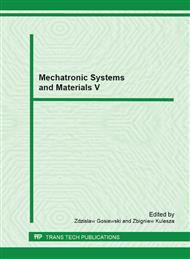[1]
S. Maillard, et al., Towards the use of passive and active infrared thermography to inspect metallic components in the mechanical industry, 10th International Conference on Quantitative InfraRed Thermography QUIRT (2010).
DOI: 10.21611/qirt.2010.081
Google Scholar
[2]
I. Flitta, T. Sheppard, Nature of friction in extrusion process and its effect on material flow, Materials Science and Technology. Vol. 19 (2003) 837-846.
DOI: 10.1179/026708303225004422
Google Scholar
[3]
P.L. Menezes, K.K. Kishore, S.V. Kailas, Influence of friction during forming processes - a study using a numerical simulation technique, International Journal of Advance Manufacturing Technologies 40 (2009) 1067–1076.
DOI: 10.1007/s00170-008-1425-5
Google Scholar
[4]
H. Zhu, X. Zhang, M.J. Couper, and A.K. Dahle, Effect of Initial Microstructure on Surface Appearance of Anodized Alimunum Extrusions, Metallurgical and Materials Transactions. Vol. 40 (2009) 3264-3275.
DOI: 10.1007/s11661-009-9976-0
Google Scholar
[5]
Z. Peng, T. Sheppard, Study of surface cracking during extrusion of aluminium alloy AA 2014, Materials Science and Technology. Vol. 20 No 9 (2004) 1179-1191.
DOI: 10.1179/026708304225022016
Google Scholar
[6]
A.F.M. Arif, et al., Product defects in aluminum extrusion and their impact on operational cost, The 6th Saudi Engineering Conference, KFUPM, Dhahran (2002). Vol. 5 137-154.
Google Scholar
[7]
A.W. Christie, What's Inside: Thermal Process Imaging Permits a Real Time View of Your Extrusion Process, TAPPI European PLACE 2005. http: /www. optexprocesssolutions. com.
Google Scholar
[8]
A. Bzymek, A. Czupryński, M. Fidali, W. Jamrozik and A. Timofiejczuk, Analysis of images recorded during welding processes, 9th International Conference on Quantitative InfraRed Thermography QUIRT (2008).
DOI: 10.21611/qirt.2008.02_04_14
Google Scholar
[9]
J. Nowacki, A. Wypych, Application of thermovision method to welding thermal cycle analysis, Journal of Achievements in Materials and Manufacturing Engineering. Vol. 40 Issue 2 (2010) 131-137.
Google Scholar
[10]
E. Solórzano, F. Garcia-Moreno, N. Babcsán, J. Banhart, Thermographic Monitoring of Aluminium Foaming Process, Journal of Nondestructive Testing and Evaluation 28 (2009) 141–148.
DOI: 10.1007/s10921-009-0056-6
Google Scholar
[11]
T.S. Wisniewski, W. Pachla, D. Kukla, A. Mazur, K.J. Kurzydłowski, Application of infrared thermography in investigation of hydrostatic extrusion, The Quantitative InfraRed Thermography (QIRT) Journal (2004) F. 8. 2-F. 8. 6.
DOI: 10.21611/qirt.2004.038
Google Scholar
[12]
E. Whitenton, High-Speed Dual-Spectrum Imaging for the Measurement of Metal Cutting Temperatures. National Institute of Standards and Technology (2010).
DOI: 10.6028/nist.ir.650e2010
Google Scholar
[13]
Raytek products. Information on http: /www. randci. co. za/raytek. html.
Google Scholar
[14]
Schmidt R.: Benefits of IR/visible fusion. Proceedings- SPIE The International Society for Optical Engineering, vol. 6541, pp.654-105 (2007).
Google Scholar
[15]
K. Chrzanowski, Non-contact thermometry. Measurement errors, Research&Development Treatises vol. 7. SPIE Polish Chapter, Warsaw, (2001).
Google Scholar


